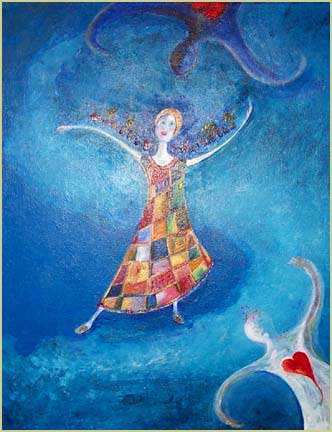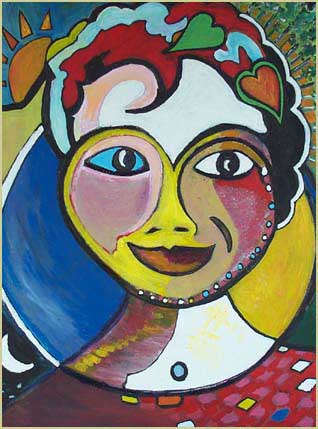A New Spirituality from an Ancient Time
sHEALy (Sherry Healy) is an artist and author of two books,
Living
Your Intuitive Dreams and Confident Child.
A recent-stirring theology with ties to an ancient spirituality is influencing our modern thoughts and times. As individuals now seek a means to heal their spirit and planet, many are finding, with refreshed optimism, a new desire for an old religion. This interest in a theology of metaphor and intrinsically-found knowledge is referred to as an awareness of the Goddess.She is beauty, love and strength. She is the changing seasons and the explosion of new life that grows in the womb. She is all life. And, we are her. And now, she has become a movement of modern times and an opportunity for spiritual peace and future growth. And today, we need her. The current study of the Goddess as an entire spirituality is known as theology, named after the Greek word “Thea” which means Goddess.
For centuries she has been forgotten by the populous, only healers, life-affirming teachers and intuitive leaders as her companions. Today however, the Goddess movement is flourishing and her methods are seeping into your daily life, bringing hope, healing oppression and promising a renewed future. Goddess-loving people originated between 35,000 and 10,000 BC. Her remnants have been found across the world, first in southern France, Africa and Egypt. Ancient societies the world over, revered her and believed her to be the source of all living things. Nevertheless, as hunting tribes and more violent societies emerged, she was pushed aside. Eventually, civilization forgot her gentle ways. The western-European Goddess began her first decline as nomadic tribes of Northern Europe introduced a male sun God. The Goddess culture soon became suppressed and her followers shamed and left to decline.
The New Hebrew religion is said to have hastened the end of the Goddess culture between the years of 1800-1500 BC. And, the Christian Church attempted with great success to abolish the Goddess all together.
Today much of the Goddess culture remains buried deep within the heaps of patriarchal literature of our modern churches and synagogues. They have recoated her with peasant attire and villainous deeds. They have portrayed her badly as Eve the temptress or Delilah the unsavory woman ignoring her strengths and promising punishment to her consorts. Yet, even in these male-celebrated times, her attributes emerge as peace-seeking individuals unbury her methods and assimilate her ways into their lives in spite of the undeserved reputation she has been poorly granted.Presently, the Goddess as a religion or purely an attitude is the fastest growing spiritual movement of the western world. With individuals seeking to know a living-breathing spirituality, the Goddess is in her second coming. New churches and spiritual centers have begun to open their doors to her. Men and women have now found it necessary to recall her wisdom in the hopes of healing repression and violence. Finally, her healing traditions are once again being recognized as the natural and life-affirming lessons and methods they have always been. And as her words promise, “Seek not beyond your own self. Seek within and you will find me.”
With the help of contemporary and open-minded leaders the ancient-Goddess traditions are resurfacing. New books are making their way to publishing companies and book shelves and falling into the hands of innovative individuals. And, those pioneering individuals are sharing the old, yet newly learned Goddess lessons and leading others to know her joys.The new word in the community is that the Goddess is alive. And that she offers news that we are in need of hearing. She allows us to experience an inner strength that a patriarchal society has forgotten to allow us. She encourages us to explore our own intuitive voices and trust our intrinsic knowledge. She tells us that we are good because we are a part of nature and that all life is to be revered.
And through her words we begin to hear and recognize world-wide injustices. And, we become determined to change them. We set our sites toward rewriting history and creating a new future. We strive to make the future “our story;” a story that encompasses both positive feminine and masculine archetypal symbols with experiential methodologies and rituals capable of presenting a new story of compassion and respect to all who are ready to learn a more life-affirming way of living. She is the world itself. She is the earth, the sky, the rain, and all that inhabits these things. As we learn to know her, we learn that revering nature, ourselves and life in general is the easiest way to connect with her.
As our western culture continues to seek life-celebrating spiritual outlets, the Goddess philosophy will continue to emerge. The forms and concepts which she guarantees us will joyously influence future generations. Her influences will be seen in the spiritual and political movements of the New Age, in the pursuits of intuition, in the birth of understanding and compassion, through united religious experiences and in the splendid act of loving one another.
We are free to know her in spite of cultural backgrounds or religious affiliations. We are liberated to trust our inner voices. And through her, we are healthier of spirit and mind. We learn to recognize that spirit is grand and too big for human understanding. We learn that one aspect of knowing the Goddess is recognizing that she is a part of our own creations. She, created as a metaphor for our own use, helps us to relate to the divine. With her, we have choices. We can know her as the earth and the seasonal changes which our calendars stress or we can know her as the voice of intuition that whispers into our dreams. We can discern her through the thousands of names and mythical characters of our ancestors. Accepting the Goddess as a spiritual philosophy allows us a myriad of avenues in which we can travel. But always, she guides us to listen to our inner voice. “Listen well”, she tells us. “I am here with you”.

by Susun S. Weed
Introduction by Jean Houston.
Superb herbal in the feminine-intuitive mode. Complete instructions for using common plants for food, beauty, medicine, and longevity. Seven herbs -- burdock, chickweed, dandelion, nettle, oatstraw, seaweed, and violet -- are explored in depth.
A Special Tenth Anniversary edition of this classic herbal, profusely illustrated. 312 pages.
Retails for $21.95
Read a Review
Order HEALING WISE in our BookshopI just started reading your book, Healing Wise. Your humor and approach to life seem so "down-to-earth", just like your favorite powerful weeds. Thank you for sharing and nourishing! ~ Diane


